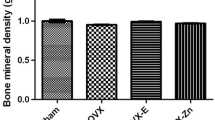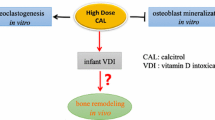Abstract
We have previously demonstrated that rat bone in vivo and rat bone cells in vitro, responded sex-specifically to gonadal steroids in stimulation of the specific activity of the BB isozyme of creatine kinase (CK), a marker for hormonal responsiveness. Pre-treatment with vitamin D analogs up-regulated the sex-specific responsiveness and sensitivity to gonadal steroids. We also found that mice cultured femoral bone marrow (BM) in the presence of dexamethasone (DEX) and 1,25(OH)2D3 (1,25D) or both differentiated into osteoblast-like cells (Obs), which acquired sex-specific responsiveness to gonadal steroids. This response was significantly augmented in the presence of both agents. In the present study, we examined the effect of age, sex and vitamin D non-hypercalcemic analogs on the differentiation of rat derived femoral BM into Obs. In female or male derived BM from intact but not gonadectomized rats DEX and DEX+1,25D increased the constitutive levels of CK. BM derived from old females showed lower stimulation of CK than BM originated from young females by estradiol (E2) or raloxifene (Ral) in the presence of both DEX and 1,25D. The non-hypercalcemic analogs of vitamin D: CB 1093 (CB), EB 1089 (EB) and MC 1288 (MC) were more effective than 1,25D in both age groups in stimulating CK in the absence of DEX. In the presence of DEX, there was a further increase in CK with the same differential effectiveness. BM from gonadectomized male or female rats lost the sex-specific response, responding to both E2 and dihydrotestosterone (DHT). BM derived from both intact and gonadectomized males and females, growing with DEX or DEX+1,25D showed increased specific activity of constitutive levels of alkaline phodphatase (AP). No significant stimulation of AP was seen in any BM by gonadal steroids. These findings suggest that manipulation of the hormonal milieu in early stages of differentiation sequence of Obs determines the subsequent selective responsiveness of the developing bone tissue to sex steroids. Also non-calcemic vitamin D analogs were more effective in this process than 1,25D and showed activity even in the absence of DEX and may be applied to the differentiation process for bone tissue engineering.
Similar content being viewed by others
References
Somjen D, Weisman Y, Harell A, Berger E, Kaye AM. Direct and sex specific stimulation by sex steroids of creatine ki-nase activity and DNA synthesis in rat bone. Proc Nat Acad Sci USA 1989, 86: 3361–5.
Berger E, Bleiberg I, Weisman Y, et al. The hormonal milieu in early stages of bone cell differentiation modifies the subsequent sex-specific responsiveness of the developing bone to gonadal steroids. J Bone Miner Res 2001, 16: 823–31.
Somjen D, Weisman Y, Mor Z, Harell A, Kaye AM. Regulation of proliferation of rat cartilage and bone by sex steroid hormones. J Steroid Biochem Mol Biol 1990, 40: 717–23.
Fournier B, Haring S, Kaye AM, Somjen D. Stimulation of creatine kinase specific activity in human osteoblast and endometrial cells by estrogens and anti-estrogens and its modulation by calciotropic hormones. J Endocrinol 1996, 150: 275–85.
Katzburg S, Ornoy Y, Hendel D, et al. Age and sex dependent stimulation of creatine kinase activity by sex steroids in normal human bone-derived cells in culture. Abst. Annual Meeting of the Israel Calcified Tissues Research Society, Jerusalem, December 1997.
Somjen D, Mor Z, Kaye AM. Age dependence and modulation by gonadectomy of the sex-specific response of rat diaphyseal bone to gonadal steroids. Endocrinology 1994, 134: 809–14.
Weisman Y, Cassorla F, Malozowski S, et al. Sex specific response of bone cells to gonadal steroids: modulation in perinatally androgenized females and testicular feminized male rats. Steroids 1993, 8: 379–88.
Somjen D, Kaye AM, Harell A, Weisman Y. Modulation by vitamin D status of the responsiveness of rat bone to gonadal steroids. Endocrinology 1989, 125: 1870–6.
Oh YS, Kim EJ, Scahffer BS, et al. Synthetic low-calcemic vitamin D3 analogs inhibit secretion of insulin-like-growth factor-binding protein-6 in conjunction with growth suppression of HT-29 colon cancer cells. Mol Cell Endocrinol 2001, 183: 141–9.
Somjen D, Waisman A, Weisman Y, Kaye AM. “Non-hyper-calcemic” vitamin D analogs augment the induction of creatine kinase B by estrogen and estrogen receptor modulators (SERMS) in osteosarcoma cells and in rat skeletal organs. J Steroid Biochem Mol Biol 2000, 72: 79–88.
Berger E, Frisch B, Lifschitz-Mercer B, Weisman Y, Somjen D. Sequential treatment with vitamin D analogs and gonadal steroids augments anabolic changes in rat bone and cartilage. Abst. 11th Inter. Workshop on Calcif Tiss, Eilat, Israel, February 7–11, 1999, p. 106.
Kaye AM, Weisman Y, Harell A, Somjen D. Hormonal stimulation of bone cell proliferation. J Steroid Biochem Mol Biol 1990, 37: 431–5.
Somjen D, Waisman A, Weisman Y, Kaye AM. Non hypercal-cemic analogs of vitamin D stimulate creatine kinase B activity in osteoblast-like ROS 17/2.8 cells and up-regulate their responsiveness to estrogens. Steroids 1998, 63: 340–3.
Somjen D, Katzburg S, Knoll E, et al. Vitamin D analogs modulate responsiveness and sensitivity of bone and vascular cells in culture and in vivo to gonadal steroids and to tissue selective receptor modulators (SERMS). Abst. 1st Intl. Conf. On Chemistry and Biology of vitamin D analogs, Providence, RI. September 1999, 26–8.
Somjen D, Katzburg S, Sharon O, et al. Modulation of response to estrogens in cultured human female bone cells by a non-calcemic Vitamin D analog: changes in nuclear and membranal binding. J Steroid Biochem Mol Biol 2004, 89-90: 393–5.
Maniatopoulos C, Sodek J, Melcher AH. Bone formation in vitro by stromal cells obtained from bone marrow of young adult rats. Cell Tissue Res 1988, 254: 317–20.
Berger E, Bleiberg I, Weisman Y, Harel A, Kaye AM and Somjen D. Differentiation of cultured mice bone marrow into osteoblast-like cells results in acquisition of sex-specific responsiveness to gonadal steroids. J Endocrinol Invest 2004, 27: 622–8.
Somjen D, Kaye AM, Binderman I. 24R, 25-dihydroxy vitamin D stimulates creatine kinase BB activity in chick cartilage cells in culture. FEBS Lett 1984, 167: 281–4.
Somjen D, Binderman I, Weisman Y. The effects of 24R, 25-dihydroxycholecalciferol and 1,25- dihydroxycholecalciferol on ornithine decarboxilase activity and on DNA synthesis in the epiphysis and diaphysis of rat bone and in the duodenum. Biochem J 1983, 214: 293–8.
Reiss N, Kaye AM. Identification of the major component of the “estrogen induced protein” of rat uterus as the BB isozyme of creatine kinase. J Biol Chem 1981, 256: 5741–9.
Nakagawa H, Takagi K, Hitaoka M, Iyma KI, Usuky G. Influence of monocyte-macrophage lineage cells on alkaline phosphatase activity of developing osteoblasts derived from rat bone marrow stromal cells. Nippon Seikeigeka Gakkai Zasshi 1993, 67: 480–9.
Bradford MM. A rapid and sensitive method for the quan-titation of microgram quantities of protein utilizing the principle of protein-dye binding. Anal Biochem 1976, 72: 248–54.
Komm BS, Terpening CM, Benz DJ, et al. Estrogen binding, receptor mRNA and biological response in osteoblast-like osteosarcoma cells. Science 1988, 241: 81–4.
Eriksen EF, Colard DS, Berg NJ, et al. Evidence of estrogen receptors in normal human osteoblast-like cells. Science 1988, 241: 84–6.
Kasperc C, Hemboldt A, Borcsok I, et al. Skeletal site-dependent expression of the androgen receptor in human osteoblastic cell populations. Calcif Tissue Int 1997, 61: 464–73.
Ernst M, Schmid Ch, Froech ER. Enhanced osteoblast proliferation and collagen gene expression by estradiol. Proc Natl Acad Sci USA 1988, 85: 2307–10.
Gray TK, Flynn TC, Gray KM, Nabell LM. 17β estradiol acts directly on the clonal osteoblast cell line UMR 106. Proc Natl Acad Sci USA 1987, 84: 854–7.
Somjen D, Weisman Y, Harell A, Berger E, Kaye AM. Direct and sex-specific stimulation by sex steroids of creatine ki-nase activity and DNA synthesis in rat bone. Proc Natl Acad Sci USA 1989, 86: 3361–5.
Walters MR. An estrogen stimulated 1,25-dihydroxyvitamin D receptor in rat uterus. Biochem Biophys Res Commun 1981, 103: 72126.
Author information
Authors and Affiliations
Corresponding author
Rights and permissions
About this article
Cite this article
Somjen, D., Kaye, A.M., Ofer, M. et al. The role of non-calcemic analogs of vitamin D in differentiation of cultured rat bone marrow into osteoblast-like cells: Age and sex differences. J Endocrinol Invest 28, 910–918 (2005). https://doi.org/10.1007/BF03345323
Accepted:
Published:
Issue Date:
DOI: https://doi.org/10.1007/BF03345323




